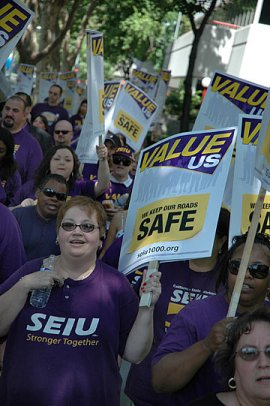Governor Arnold Schwarzenegger approved $7 billion in cuts in October to help fill a $15.2 billion crater in California’s budget, leveling a broad attack on unions and working people as the world’s tenth-largest economy teeters.
Unemployment in California rose to 7.7 percent in August, its highest in a decade. Many of the new jobless are temporary state workers, 10,000 of whom were laid off this summer. “Working in the public sector is increasingly an emotionally difficult place to work,” said Dave Hart, president of the California State Employees Association, representing over 140,000 state workers. “You’re now at the whim of politics.”
Service Employees Local 1000 has won contract language protecting some temporary workers who work full-time hours. Those without permanent status, including retirees doing part-time work, were laid off. “A lot of these retirees had dwindling pensions, and were coming back to work to make ends meet,” said Cathy Hackett, an SEIU bargaining representative.
The deep cuts have put at least one state agency in a good position to bargain for exemptions. “The people in the unemployment insurance office are putting in overtime,” Hackett said. “They cannot keep up with the claims.”
CAN’T FIND ANOTHER WAY
Public sector unions defeated the governor’s attempt to lower state workers’ pay to the federal minimum wage pending a budget agreement over the summer. Now they’re challenging the state’s threat to do the same in January, when California will face another budget gap.
Tax revenues plummeted as consumers have cut back spending. Just weeks after signing a budget full of stop-gap borrowing schemes, the governor called an October emergency meeting to address a newly developing $1 billion deficit in expected tax revenue for the year.
The California Federation of Teachers says much of the budget hole could be fixed by reinstating vehicle registration fees and raising income tax rates 2 percent for just the top earners—those making over $300,000 a year.
California’s constitution makes it one of three states where a two-thirds majority is required in the legislature to raise taxes, but only a simple majority to cut them.
“The wealthy have been huge beneficiaries of regressive tax policies, while we have gone from No. 1 to No. 48 in funding public education,” said Kent Wong at UCLA’s Center for Labor Research and Education. The University of California’s labor program, with a $6 million budget, was the only research program cut from the budget.
At the University of California, service workers in AFSCME Local 3299, who held a five-day strike this summer, continue their bargaining struggle after the school refused demands to boost poverty wages. Nearly all the custodians, groundskeepers, and bus drivers that work for UC are eligible for some form of public assistance.
Bargaining just got harder, as the new budget slashes higher education funding. “The school blames budget cuts whether or not it’s the case,” said President Lakesha Harrison. “We know they spend frivolously, and our demands stay the same.”
Still, hospital workers represented by Local 3299 won increases to $14.50 an hour in a five-year contract announced October 20.
The governor terminated a proposal—pushed by Local 3299 in the legislature—to divert $15 million from administrators’ salaries to fund pay increases for low-wage workers.
Base funding for K-12 schools and community colleges fell by $3.3 billion. In Los Angeles, the budget crisis is one more hurdle for teachers at impasse in contract negotiations with the school district. The teachers union, threatened with a 3.5 percent pay cut, is planning larger job actions than the one-hour walkout it held in July.
Thin state budgets make local governments—and contract mediators—even less receptive to worker demands.
In response, eight unions of L.A. workers, including the teachers, are presenting a unified front, despite some historical rifts, to bargain health benefits with the school district.
NO MORE BORROWING
California state college employees are feeling the squeeze. The system received $215 million less than expected right when student enrollment is spiking.
“We have health centers with a line outside each morning, there are new buildings without maintenance staff, and things are deteriorating,” said Pat Gantt, president of the California State University Employees Union.
County health care programs for low-wage workers lost $42 million. Cuts to the state-mandated ombudsman program mean crippling layoffs for those who oversee state-funded but privately owned nursing homes. “These are people who find the neglect and abuse in long-term care facilities,” said Michael Connors of California Advocates for Nursing Home Reform. “They are eyes and ears for the community.”
California has taken short-term loans to cover costs during periods of weak tax revenue in the past. The global credit crisis makes this a less feasible way out. Union leaders say anger is growing among members who see that financial institutions will survive the crisis while public services take major hits.
“The opposition to the $700 billion bailout was a good indication that people smelled the rat,” said AFT Vice President Joshua Pechthalt. “We are moving into a period when they are going to be open to new ways of solving this.”







